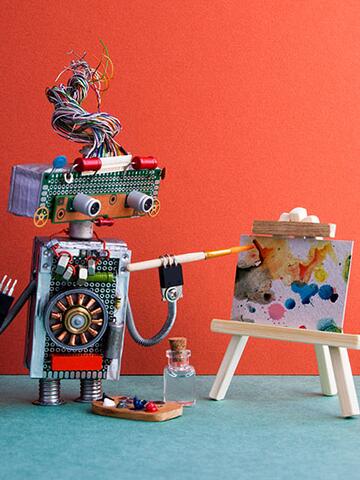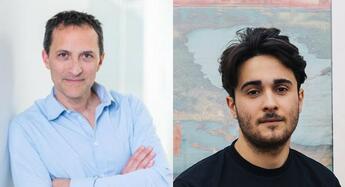

When art meets artificial intelligence
In a world where technology shapes our daily lives at a breakneck pace, one question persists: can artificial intelligence become creative?
Matthieu Cord, computer science professor specializing in artificial intelligence (AI), and Hugo Caselles-Dupré, co-founder of the Obvious collective and pioneer in the use of AI in artistic creation, explore synergies, ethical challenges and future horizons of the fusion between art and algorithms.
How does generative AI differ from human creativity, and how can these two forms of creation collaborate or complement each other?
Hugo Caselles-Dupré: Today, art is not defined by technique, but by a person's desire to express a message and connect with their audience. For the moment, algorithms cannot have any intention or autonomy to create, since they are always developed by a human. However, generative AI opens up new perspectives for artists by offering them unprecedented technical and aesthetic possibilities.
Concretely, it revolutionizes creative processes by facilitating certain stages of creation and broadening the field of possibilities. For example, it can provide artists with tools to more quickly produce sketches, prototypes or different strategies to develop a given theme. In the field of writing, AI is capable of reproducing implicit rules used in the construction of novels or screenplays. For visual creation, it can create an image according to the style of a particular artist, based on the images provided to it during learning.
Matthieu Cord: Similar to what happened in the case of chess or go, AI makes it possible to find combinations and positions still unexplored by humans. In this way, it can act as a catalyst for inspiration and experimentation and automatic generation algorithms open up new creative avenues in the artistic field.
Can you share examples of art projects made with AI?
H. C. D.: In our Obvious collective, for example, we created the Belamy series of paintings, a series of eleven portraits, one of which was selected by Christie's and sold at auction in New York for nearly half a million dollars. . In this work, it is not a question of image retouching, but rather of the production of images generated using algorithms, similar to those used in research, and trained on a vast corpus of artistic works.
M. C.: We can also talk about the project around the unfinished play, L’Astrologue, by Molière. Colleagues from the Faculty of Arts and Humanities asked us to generate text in the author's style by training algorithms on the writings of Molière. The objective was then to work with the Théâtre Molière Sorbonne to refine these algorithms and have an increasingly relevant generation. At the same time, image generation algorithms could be used to create suggestions for costumes, sets and staging that harmonize with the aesthetic of the era.
Can you tell us a few words about the Renaissance project that you are leading together and which is funded by the National Research Agency?
H. C. D.: The objective of this project, coordinated by our Obvious research laboratory,is to develop open source architectures to generate quality videos from sequences of sentences. After describing images with words, then with sentences, AI now makes it possible to create content--text, video image--from a text prompt. But while image generators from text already exist, generating videos remains a challenge.
M. C.: We are therefore seeking, through this project, to create open and transparent tools to allow the community to build new models in this area. This is an important direction following recent changes in the publication policy of certain AI players!
What are the ethical challenges related to the use of AI in artistic creation?
H. C. D.: It raises several important concerns such as the question of the originality and authenticity of the works generated, the question of responsibility and transparency in the creative process, copyright and intellectual property, or even the risks of manipulation. But these ethical issues have always accompanied major technical revolutions. Let's think about the arrival of photography in 1850: at the time, it was seen as a disruptive technology, reserved for engineers, and which would extinguish art. Today, we all agree that photography is an artistic field in its own right that has not killed painting, but has transformed it.
M. C.: I would qualify this comparison. Unlike the camera, AI has “cognitive” capabilities. For example, she has the ability to summarize, make a detailed proposal, write a story, etc. The ethical issues linked to creation are therefore different.
For now, the idea of a machine capable of creating autonomously remains in the realm of science fiction.
What are the creative areas where AI could have the biggest impact?
H. C. D.: I see two types of impact. First, its use for commercial purposes, where AI can be exploited to respond to requests for visual creation without added artistic value, such as the production of promotional content. As AI can work continuously and accept an infinite amount of feedback, its use risks leading to changes in the graphics industry and threatening traditional employment. It is therefore necessary to put in place measures to adapt the skills of professionals in the sector to use these tools.
The second major impact concerns Art with a capital A, where the conceptual approach to artwork takes precedence over simple technicality. Today, using AI to create aesthetically beautiful images is not enough to make a work artistically meaningful. In this respect, although generative AI may become a common tool in creation, it will not replace the artists themselves.
Will the machine one day be sufficiently autonomous to create its own prompt?
H. C. D. : For the moment, the idea of a machine capable of creating autonomously remains science fiction. Current AI algorithms are still dependent on guidelines and constraints provided by humans, and their ability to produce artistic works is limited by the data and models they are trained on. The day the machine is capable of this, I think art will be the least of our worries!
M. C.:
This question of autonomy has been debated for a long time. If we look at what has happened in the field of gaming, we see that today a human no longer plays Go against a machine in order to beat it. The best players can no longer compete with the best AI programs. But that doesn't prevent competition between humans who always have a lot of fun playing. What interests us most in chess or go is the interaction with another human being.
The same goes for art: we can use the machine to create, but what we appreciate above all in a work of art is the fact of knowing that we share a commun humanity? Doesn’t the essence of art ultimately lie in the emotional and intellectual connection between creator and viewer?
Matthieu Cord is a computer science professor specializing in artificial intelligence. He leads the Machine learning and information access (MLIA) team at the Institute for Intelligent Systems and Robotics (ISIR). His work focuses on computer vision and the semantic interpretation and description of images.
Hugo Caselles-Dupré is co-founder of the Obvious artistic trio, which explores the impacts of AI on society and art. He has a doctorate in machine learning, and former post-doc at ISIR, he explores the possibilities offered by algorithms for artistic creation.

